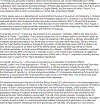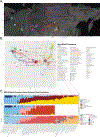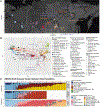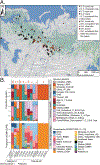Ancient DNA reveals the prehistory of the Uralic and Yeniseian peoples
- PMID: 40604287
- PMCID: PMC12342343
- DOI: 10.1038/s41586-025-09189-3
Ancient DNA reveals the prehistory of the Uralic and Yeniseian peoples
Abstract
The North Eurasian forest and forest-steppe zones have sustained millennia of sociocultural connections among northern peoples, but much of their history is poorly understood. In particular, the genomic formation of populations that speak Uralic and Yeniseian languages today is unknown. Here, by generating genome-wide data for 180 ancient individuals spanning this region, we show that the Early-to-Mid-Holocene hunter-gatherers harboured a continuous gradient of ancestry from fully European-related in the Baltic, to fully East Asian-related in the Transbaikal. Contemporaneous groups in Northeast Siberia were off-gradient and descended from a population that was the primary source for Native Americans, which then mixed with populations of Inland East Asia and the Amur River Basin to produce two populations whose expansion coincided with the collapse of pre-Bronze Age population structure. Ancestry from the first population, Cis-Baikal Late Neolithic-Bronze Age (Cisbaikal_LNBA), is associated with Yeniseian-speaking groups and those that admixed with them, and ancestry from the second, Yakutia Late Neolithic-Bronze Age (Yakutia_LNBA), is associated with migrations of prehistoric Uralic speakers. We show that Yakutia_LNBA first dispersed westwards from the Lena River Basin around 4,000 years ago into the Altai-Sayan region and into West Siberian communities associated with Seima-Turbino metallurgy-a suite of advanced bronze casting techniques that expanded explosively from the Altai1. The 16 Seima-Turbino period individuals were diverse in their ancestry, also harbouring DNA from Indo-Iranian-associated pastoralists and from a range of hunter-gatherer groups. Thus, both cultural transmission and migration were key to the Seima-Turbino phenomenon, which was involved in the initial spread of early Uralic-speaking communities.
© 2025. The Author(s), under exclusive licence to Springer Nature Limited.
Conflict of interest statement
Competing interests: The authors declare no competing interests.
Figures


















References
-
- Черных ЕН & Кузьминых СВ Древняя металлургия Северной Евразии (сейминско-турбинский феномен). (1989).
-
- Janhunen J Proto-Uralic—what, where, and when? The quasquicentennial of the Finno-Ugrian society 258, 57–78 (2009).
Publication types
MeSH terms
Substances
Grants and funding
LinkOut - more resources
Full Text Sources
Research Materials

